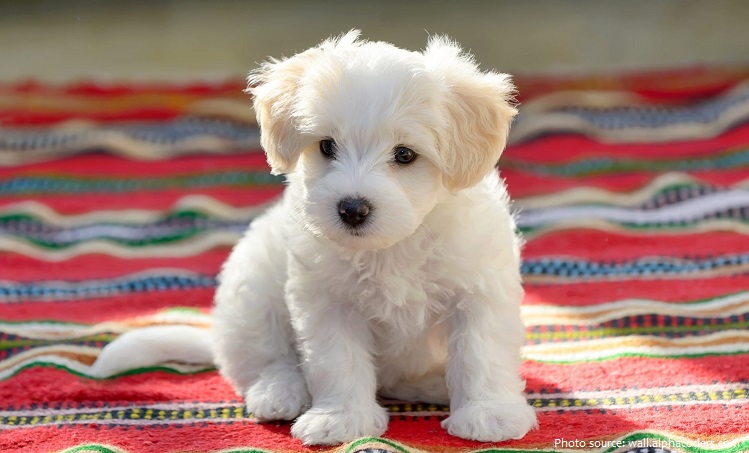
The Maltese is a breed of dog in the toy group.
It is known for its long, silky white hair.
This dog breed is intelligent and compact, making it a conveniently portable little dog.
It stands about 13 centimeters (5 inches) tall and weighs no more than 3 kilograms (7 pounds).
The coat is typically long and silky and lacks an undercoat. The color is pure white and although cream or light lemon ears are permissible, they are not desirable. Some individuals may have curly coat, but this is outside the standard. This type of coat is often referred to as “couton”, or “cotton”, in French.

Maltese look delicate, but they are very lively and playful. The dogs have been raised to be companions for people. They are very affectionate and enjoy sitting in people’s laps.
The average lifespan of the Maltese is 12 to 15 years.
The Maltese descends from one of the most ancient dog breeds to be found in recorded history.
Although the ancient Greeks and Romans believed the dog originated on the Island of Malta – they called the breed the Melitaie Dog – Melitaie being the ancient name for Malta – there is really no evidence that proves the dog was indigenous to the Island, but rather that the Maltese is descended from a Spitz-type dog bred by the peoples of the area which is now south central Europe.

The Greeks of the fourth and fifth centuries BC were fascinated by the Maltese’s geometric beauty and left behind a rich legacy of breed-specific treasures: The “Melitaie Dog” is depicted on Golden Age ceramics, and Aristotle refers to it as “perfectly proportioned,” notwithstanding a diminutive stature.
Aristocrats of the Roman Empire perfected the Maltese’s role of status symbol and fashion statement.
One legend concerns Saint Paul, the peripatetic apostle of early Christianity. The Acts of the Apostles recounts Paul’s shipwreck on Malta, where he miraculously healed the father of the island’s Roman governor, Publius. The grateful Publius, so the story goes, presented Paul with a Maltese.
The breed was eventually distributed as an exotic article of trade from the ancient island trading center of Malta, hence the name, and from there migrated by caravans to the farthest reaches of the civilized world, including: the Middle East, Tibet, China, the Philippines, and Japan.

After the fall of Rome, it was Chinese breeders who kept the Maltese from extinction during Europe’s Dark Ages.
This breed became popular among upper-class ladies in England in the 1300s.
Some royals that purportedly owned Maltese were Mary Queen of Scots, Queen Elizabeth I, Queen Victoria, Josephine Bonaparte and Marie Antoinette.
The dog was particularly popular in England during Elizabethan times (the late 16th century). Two notable owners of Maltese in those times were Queen Elizabeth I and Mary Queen of Scots.

In 1862, 20 Maltese were exhibited at a show in London. The Kennel Club (England) was established in 1873.
Toward the late 1800s, the Maltese was introduced to the US and was officially recognized by the American Kennel Club in 1888. The breed has remained relatively popular to this day.
Like all dogs, the Maltese needs proper training and socialization in order to be happy and well-adjusted.
Many toy breeds and small dogs are known to have high-pitched voices. While Maltese dogs are not given to excessive barking, they will sound the alarm at noises in the night. In fact, legend has it that the ancient Romans would use dogs similar to Maltese as alarm dogs, and raised them with Rottweilers, or a proto-Rottweiler breed. Intruders would first be confronted with the diminutive Maltese, only to be later confronted with their more formidable companions.

Unlike many small breeds, the Maltese was not bred down from larger sizes – it has always been a very small dog.
While breeders with low standards may charge as little as $600, for a pet-quality Maltese, you can generally expect to pay about $2,500 for a male and more than $3,000 for a female. Show-quality dogs and those with breeding rights are often well over $4,000.

Regular grooming is required to prevent the coats of non-shedding dogs from matting. Many owners will keep their Maltese clipped in a “puppy cut,” a 2.5 to 5 cm (1 to 2 in) all over trim that makes the dog resemble a puppy. Some owners, especially those who show Maltese in the sport of conformational dog shows, prefer to wrap the long hair to keep it from matting and breaking off, and then to show the dog with the hair unwrapped combed out to its full length.
Considered to be a hypoallergenic dog breed, it may be suitable for those who are mildly or moderately allergic to dogs.